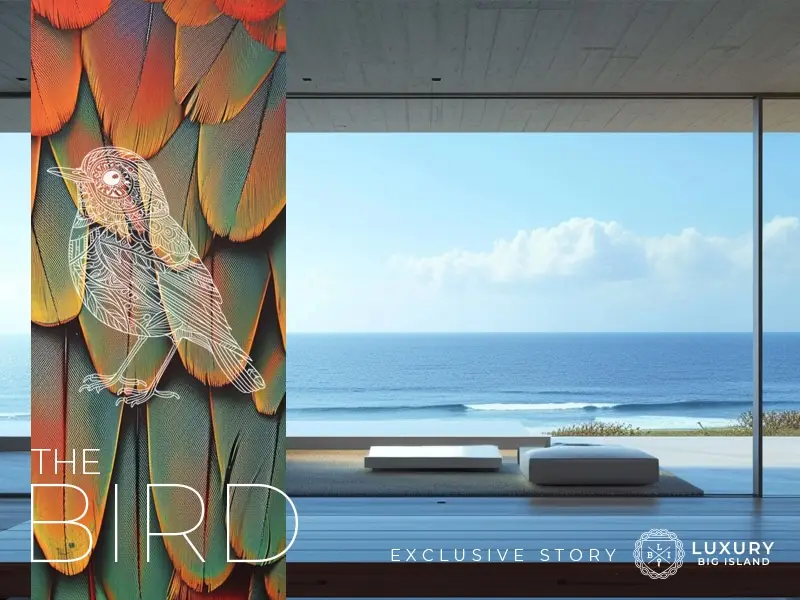In the 1970s, Sterling was the only American professional playing tennis at a certain resort in Japan. Graceful, talented, and charismatic, he became close to the owner of the resort, a wealthy man with investments all over the world. This gentleman had once traveled to the Big Island of Hawaii, where its powerful, raw nature made a lasting impression, leading him to purchase thousands of acres in one of the oldest parts of the island, with gorgeous eroded mountains and impressive waterfalls.
At the Japanese resort, he asked a young Sterling to fly to the Big Island with him to oversee his land and investments. Sterling , ever-charming, shared that he wouldn’t know much about the trade, let alone Hawaii, but this didn’t dissuade the gentleman from sending him over. Quick-witted, Sterling quickly learned about the land, its culture, and its inhabitants. The Japanese gentleman planned to build an exquisite resort in Hawaii.
Towards the end of the 1980s, the Japanese market crash occurred, and Sterling ended up selling most of the gentleman’s land. However, he asked if he could secure a 20-acre piece for himself. Twenty acres might not sound like much, but Sterling had picked the best 20 acres he had ever set foot on. It was a privileged belt up in the valley, with sweeping ocean views, lush greenery, and known by Hawaiians as the land of the rainbows. Light rains filtered through the sunshine, reflecting prisms and bands of colors in the sky.
A couple of decades later, Sterling’s profound love for his mentor—a man with a Wimbledon title and more than 100 Davis Cup matches, but more importantly, an artist and philosopher—ran so deep that he decided to build a house on this land, resembling a bird that his mentor had once drawn and water-colored.
The Masterpiece
The house itself was a work of art. Sterling spent all the money he had earned throughout his life building it—a massive concrete structure, with windows framing the rainbows from every angle, and a level of quality rarely seen in Hawaii. A grand entrance adorned by an immense Chihuly chandelier, spacious living spaces, and supreme outdoor areas to honor the natural environment—all state of the art. The perfect place for anyone to fully live off the grid, if desired.
Sterling realized his masterpiece had been completed and, more importantly, that he needed the investment funds back. We had an instant connection and walked out of that first meeting with clear instructions to find a buyer to pay the 8-digit asking price.
The Challenges
There were a few challenges. There had never been a sale in this area at such a price, with less than a handful of sales at half that price. The house had been built in the shape of a bird, and despite its larger-than-life feel, it only had 3 bedrooms—most of the square footage had been allocated to the large common areas. I knew the property had to be privately listed, or, if publicly listed, the time waiting for a buyer to show up would have a devastating effect.
A couple of months went by without any showings. Despite the financial strain he was under, Sterling sustained his composure and calmness; he had put all his trust in me. He maintained “his Zen,” probably a product of having lived in Japan for so many years.
The Turning Point
I never asked myself how I would sell such a home, as I had never before received a call in that portion of the island from someone inquiring within such a price range. Days went by, weeks… months. And, of course, the phone rang. Someone had given my number to Fontaine. As I listened to the reason for his call, he said, “I want a place remote, away from everything, yet that feels sturdy like a bunker, where I could live the rest of my life off the grid…” At the same time, he made it clear it had to be special, “where I can drop any seed and watch it grow, fertile, with a sense of expansiveness… views….”
Of course, that was Sterling’s. I will never forget when I picked him up from the hotel, meeting him in person for the first time, and he asked, “Besides Sterling’s, what else will we be looking at?” “Nothing,” I said. “There is no Plan B. This will be your home.” We drove for 45 minutes, and took a gravel road amidst the pastures. Prior to arriving at Sterling’s, an old two or three-story house stood by the side of the road, eerie—the type of home you’d find in a horror movie, faded and colorless. The sort of house that looks abandoned while you know someone is living in it. One of the heiresses to the largest railway fortunes in the US lives in it. Far, isolated, young, uneasy behavior. Living in utter remoteness and simplicity, while possessing one of the largest fortunes in the country.
We passed the house, and further down the road, we arrived at Sterling’s. The palm trees, rainbows, green pastures, and, of course, the bird. Fontaine not only purchased it but entirely took it to the next level. Sterling, to this day, sends me a monthly text from somewhere in the world, gathering crab and shrimp on the San Juan Islands, with his new Porsche GTS, his penthouse in Vancouver, a new house in Kyoto, and a smaller ranch purchased on the Hawaiian islands. All the financial stress, which severely weakened the heart of his adorable wife, who was always working in the garden, vanished. Filled with life, with hope, with a new path ahead. With money.
Fontaine hunts in Idaho, goes fishing in Alaska and Kona, grills on his Kalamazoo, loves wine, good company, and invites me to visit him at the Bird, “to witness the shooting stars as they go to sleep behind the mountain.”
To understand the artistic inspiration behind Sterling’s unique masterpiece, explore this Chihuly glass art collection, known for its stunning use of color and form that mirrors the natural beauty of Hawaii’s landscapes.
If you’re captivated by the story of Sterling’s masterpiece and are interested in exploring similar exclusive opportunities, connect with Harold X Clarke today to discover private listings and upcoming properties that suit your unique desires.



